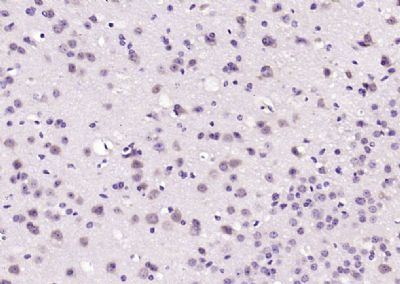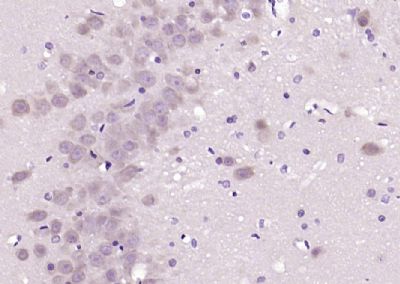PAFAHG Polyclonal Antibody
Purified Rabbit Polyclonal Antibody (Pab)
- 产品详情
- 实验流程
Application
| IHC-P, IHC-F, IF, E |
|---|---|
| Primary Accession | Q15102 |
| Reactivity | Rat, Pig, Dog, Bovine |
| Host | Rabbit |
| Clonality | Polyclonal |
| Calculated MW | 25734 Da |
| Physical State | Liquid |
| Immunogen | KLH conjugated synthetic peptide derived from human PAFAH1B3/PAFAHG |
| Epitope Specificity | 1-100/231 |
| Isotype | IgG |
| Purity | affinity purified by Protein A |
| Buffer | 0.01M TBS (pH7.4) with 1% BSA, 0.02% Proclin300 and 50% Glycerol. |
| SUBCELLULAR LOCATION | Cytoplasm. |
| SIMILARITY | Belongs to the 'GDSL' lipolytic enzyme family.Platelet-activating factor acetylhydrolase IB beta/gamma subunitssubfamily. |
| SUBUNIT | Cytosolic PAF-AH IB is formed of three subunits of 45 kDa(alpha), 30 kDa (beta) and 29 kDa (gamma). The catalytic activityof the enzyme resides in the beta and gamma subunits, whereas thealpha subunit has regulatory activity. Trimer formation is notessential for the catalytic activity. |
| Important Note | This product as supplied is intended for research use only, not for use in human, therapeutic or diagnostic applications. |
| Background Descriptions | The platelet activating factor (PAF) acetylhydrolases catalyze hydrolysis of the sn-2 ester bond of PAF and related pro-inflammatory phospholipids and thus attenuate their bioactivity. The family of PAF acetylhydrolases includes one secreted plasma isozyme and two intracellular isozymes. The intracellular isozymes are distinguished by differences in their primary sequence, tissue localization, subunit composition and substrate preferences. The most thoroughly characterized intracellular isoform, PAFAH1B, is a heterotrimeric protein expressed in brain tissue and plays and important role in brain development and function. PAFAH1B is comprised of a regulatory subunit (LIS1) and two homologous (63% identity) catalytic subunits (PAFAH1B2 and PAFAH1B3), which harbor all the activity of the enzyme. The PAFAH1B2 and PAFAH1B3 subunits readily associate with very high affinity to form heterodimers, and this dimerization is essential for both stability and catalytic activity. PAFAH1B3 is also commonly known as PAFAH1B 29kDa subunit, PAFAH1B subunit or PAFAH1B subunit α1. |
| Gene ID | 5050 |
|---|---|
| Other Names | Platelet-activating factor acetylhydrolase IB subunit alpha1, 3.1.1.47, PAF acetylhydrolase 29 kDa subunit, PAF-AH 29 kDa subunit, PAF-AH subunit gamma, PAFAH subunit gamma, PAFAH1B3 (HGNC:8576), PAFAHG |
| Target/Specificity | In the adult, expressed in brain, skeletal muscle, kidney, thymus, spleen, colon, testis, ovary and peripheral blood leukocytes. In the fetus, highest expression occurs in brain. |
| Dilution | IHC-P=1:100-500,IHC-F=1:100-500,IF=1:50-200,ELISA=1:5000-10000 |
| Format | 0.01M TBS(pH7.4) with 1% BSA, 0.09% (W/V) sodium azide and 50% Glyce |
| Storage | Store at -20 °C for one year. Avoid repeated freeze/thaw cycles. When reconstituted in sterile pH 7.4 0.01M PBS or diluent of antibody the antibody is stable for at least two weeks at 2-4 °C. |
| Name | PAFAH1B3 (HGNC:8576) |
|---|---|
| Synonyms | PAFAHG |
| Function | Alpha1 catalytic subunit of the cytosolic type I platelet- activating factor (PAF) acetylhydrolase (PAF-AH (I)) heterotetrameric enzyme that catalyzes the hydrolyze of the acetyl group at the sn-2 position of PAF and its analogs and modulates the action of PAF. The activity and substrate specificity of PAF-AH (I) are affected by its subunit composition. Both alpha1/alpha1 homodimer (PAFAH1B3/PAFAH1B3 homodimer) and alpha1/alpha2 heterodimer(PAFAH1B3/PAFAH1B2 heterodimer) hydrolyze 1-O-alkyl-2-acetyl-sn-glycero-3-phosphoric acid (AAGPA) more efficiently than PAF, but they have little hydrolytic activity towards 1-O-alkyl-2-acetyl-sn-glycero-3-phosphorylethanolamine (AAGPE). Plays an important role during the development of brain. |
| Cellular Location | Cytoplasm. |
| Tissue Location | In the adult, expressed in brain, skeletal muscle, kidney, thymus, spleen, colon, testis, ovary and peripheral blood leukocytes. In the fetus, highest expression occurs in brain |
Research Areas
For Research Use Only. Not For Use In Diagnostic Procedures.
Application Protocols
Provided below are standard protocols that you may find useful for product applications.
终于等到您。ABCEPTA(百远生物)抗体产品。
点击下方“我要评价 ”按钮提交您的反馈信息,您的反馈和评价是我们最宝贵的财富之一,
我们将在1-3个工作日内处理您的反馈信息。
如有疑问,联系:0512-88856768 tech-china@abcepta.com.
¥ 1,500.00
Cat# AP59417























 癌症的基本特征包括细胞增殖、血管生成、迁移、凋亡逃避机制和细胞永生等。找到癌症发生过程中这些通路的关键标记物和对应的抗体用于检测至关重要。
癌症的基本特征包括细胞增殖、血管生成、迁移、凋亡逃避机制和细胞永生等。找到癌症发生过程中这些通路的关键标记物和对应的抗体用于检测至关重要。 为您推荐一个泛素化位点预测神器——泛素化分析工具,可以为您的蛋白的泛素化位点作出预测和评分。
为您推荐一个泛素化位点预测神器——泛素化分析工具,可以为您的蛋白的泛素化位点作出预测和评分。 细胞自噬受体图形绘图工具为你的蛋白的细胞受体结合位点作出预测和评分,识别结合到自噬通路中的蛋白是非常重要的,便于让我们理解自噬在正常生理、病理过程中的作用,如发育、细胞分化、神经退化性疾病、压力条件下、感染和癌症。
细胞自噬受体图形绘图工具为你的蛋白的细胞受体结合位点作出预测和评分,识别结合到自噬通路中的蛋白是非常重要的,便于让我们理解自噬在正常生理、病理过程中的作用,如发育、细胞分化、神经退化性疾病、压力条件下、感染和癌症。







